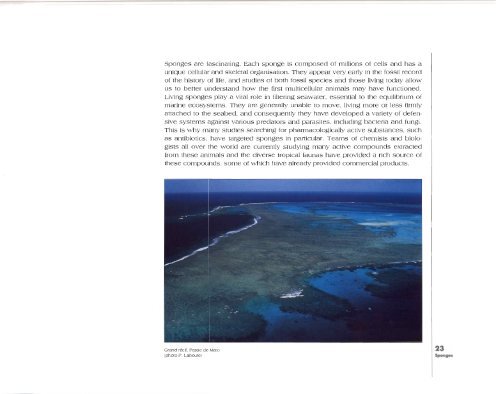Sponges of the New Caledonian lagoon - IRD
Sponges of the New Caledonian lagoon - IRD
Sponges of the New Caledonian lagoon - IRD
You also want an ePaper? Increase the reach of your titles
YUMPU automatically turns print PDFs into web optimized ePapers that Google loves.
<strong>Sponges</strong> are fascinating. Each sponge is composed <strong>of</strong> millions <strong>of</strong> cells and has a<br />
unique cellular and skeletal organisation. They appear very early in <strong>the</strong> fossil record<br />
<strong>of</strong> <strong>the</strong> history <strong>of</strong> life, and studies <strong>of</strong> both fossil species and those living today allow<br />
us to better understand how <strong>the</strong> first multicellular animals may have functioned.<br />
Living sponges play a vital role in filtering seawater, essential to <strong>the</strong> equilibrium <strong>of</strong><br />
marine ecosystems. They are generally unable to move, living more or less firmly<br />
attached to <strong>the</strong> seabed, and consequently <strong>the</strong>y have developed a variety <strong>of</strong> defensive<br />
systems against various predators and parasites, including bacteria and fungi.<br />
This is why many studies searching for pharmacologically active substances, such<br />
as antibiotics, have targeted sponges in particular. Teams <strong>of</strong> chemists and biologists<br />
all over <strong>the</strong> world are currently studying many active compounds extracted<br />
from <strong>the</strong>se animals and <strong>the</strong> diverse tropical faunas have provided a rich source <strong>of</strong><br />
<strong>the</strong>se compounds, some <strong>of</strong> which have already provided commercial products.<br />
Grand recif, Passe de Mato<br />
(photo P. Laboute)<br />
23<br />
<strong>Sponges</strong>

















